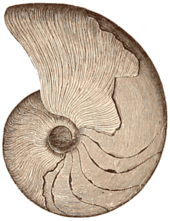Belosaepia
| Belosaepia | |
|---|---|
| Scientific classification | |
| Kingdom: | Animalia |
| Phylum: | Mollusca |
| Class: | Cephalopoda |
| Order: | Sepiida |
| Family: | †Belosaepiidae |
| Genus: | †Belosaepia |
| Species | |
Belosaepia, occasionally incorrectly Belosepia,[2] is a genus of cuttlefish-like cephalopod known from the Eocene.[1]
Morphology
Belosaepia reached 18 centimetres (7.1 in) in length and 5 centimetres (2.0 in) across; it had a large siphuncle that penetrated its oblique septa.[1] The shell was endogastrically coiled.[1] It had a small belemnite-like guard, which took the form of a short horn at the posterior end of the shell;[1] usually, only a small portion of the shell closest to the guard is preserved. The chambers in the shell closely resemble those present in the cuttlebone of modern cuttlefish.[1]
Ecology
Belosaepia lived close to the sea floor.[1]
References
- 1 2 3 4 5 6 7 8 Yancey, T. E.; Garvie, C. L.; Wicksten, M. (2010). "The Middle Eocene Belosaepia ungula (Cephalopoda: Coleoida) from Texas: Structure, Ontogeny and Function" (PDF). Journal of Paleontology. 84 (2): 267–287. doi:10.1666/09-018R.1.
- ↑ e.g. "Functional Morphology of the Eocene Coleoid Belosepia".
This article is issued from
Wikipedia.
The text is licensed under Creative Commons - Attribution - Sharealike.
Additional terms may apply for the media files.
